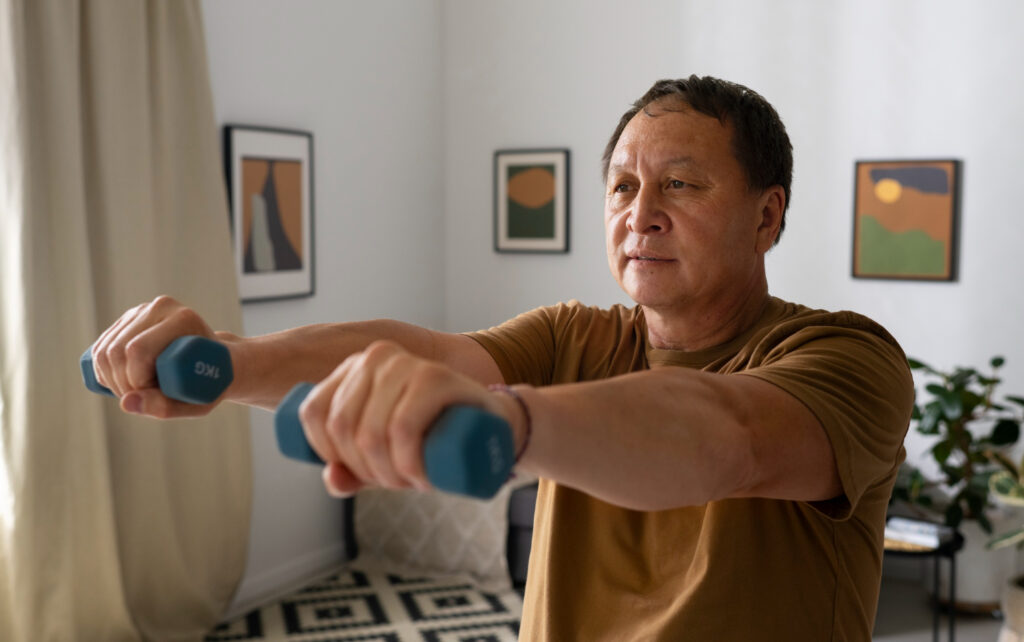
Best Workouts to Boost Testosterone Levels Naturally
Testosterone plays a key role in men’s health, influencing muscle mass, energy levels, mood, and libido. Understanding how to boost testosterone naturally can lead to better overall health and performance. Naturally increasing testosterone levels can be achieved through specific workouts that are designed to stimulate hormone production.
Exercise is one of the most effective ways to enhance testosterone levels. From compound strength training to high-intensity interval training (HIIT), various workout styles offer distinct benefits. Including these exercises in your routine can help you feel stronger, more energetic, and confident. This guide explores the best workouts to naturally increase testosterone, providing practical tips and sample routines to integrate into your fitness plan.
Understanding Testosterone and Its Role in Men’s Health
Testosterone is a hormone primarily produced in the testicles. It plays a key role in developing male reproductive tissues, promoting secondary sexual characteristics such as increased muscle and bone mass, as well as the growth of body hair.
This hormone is crucial for maintaining strength, regulating mood, enhancing libido, and boosting energy. High testosterone levels help maintain muscle mass, boost the mood, enhance libido, and increase overall energy levels. It impacts various aspects of health, including cardiovascular health and cognitive function.
Exercise significantly impacts natural testosterone production. Physical activities, especially those involving strength and high-intensity workouts, help stimulate testosterone production. Regular workouts improve overall hormone balance, reduce body fat, and lead to higher testosterone levels.
The Most Effective Workouts for Testosterone Boost
To give your testosterone a boost, here are some exercises to consider:
Compound Strength Training (Heavy Lifting)
Compound strength training involves exercises that work multiple joints and muscles simultaneously. Examples include squats, deadlifts, bench press, and overhead press. These movements are highly effective in stimulating testosterone production.
Multi-joint movements cause a significant hormonal response, leading to increased levels of testosterone and growth hormone. This boost is vital for muscle growth and overall health. Aim for optimal rep ranges of 6-12 per set to maximize testosterone release.
High-Intensity Interval Training (HIIT)
HIIT consists of short bursts of intense exercise, followed by rest or low-intensity periods. This workout effectively supports fat loss and boosts testosterone levels. It involves maximum effort for a short time, followed by a rest period.
HIIT workouts are accessible and can be customized to suit various fitness levels—no sprinting required. A great beginner-friendly routine might include 30 seconds of jumping jacks, followed by 30 seconds of bodyweight squats, and then 30 seconds of modified push-ups, with a 30-second rest after each round. This simple circuit can be repeated three to four times and offers an effective way to elevate your heart rate, stimulate testosterone production, and improve metabolic and cardiovascular health, all without needing advanced fitness experience or equipment.
Sprint Workouts
Sprint intervals are more effective than steady-state cardio in boosting testosterone. They involve short, intense sprints repeated over a session. This approach maximizes anabolic hormone response, supporting muscle growth and fat loss.
Incorporate sprint workouts into your weekly routine by performing 20-30 seconds of all-out sprints followed by 1-2 minutes of rest. Aim for 6-10 repetitions per session. Adapting these workouts into your schedule can lead to significant hormone benefits.
Bodyweight & Functional Training
Bodyweight exercises, such as push-ups, pull-ups, and lunges, combined with functional training using kettlebells, provide excellent testosterone-boosting benefits. These workouts are practical for at-home sessions, travel, and daily routines.
Functional training improves muscle tone and testosterone levels with minimal equipment. Try combining exercises like lunges with kettlebell swings to engage multiple muscle groups and stimulate hormone production.
Exercises That May Lower Testosterone If Overdone
Chronic cardio, such as marathon running, can elevate cortisol levels, which may in turn lower testosterone levels. High levels of cortisol, the stress hormone, can negate the positive effects of testosterone, leading to fatigue and muscle loss.
Overtraining without adequate recovery impacts testosterone levels negatively. Pushing your body too hard without rest can cause stress, disrupt sleep, and lead to burnout. It’s crucial to find a balance between intense workouts and sufficient recovery time.
Balancing movement and rest is vital. Alternate between high-intensity workouts and rest days to allow muscle recovery and hormone balance. Incorporating lighter activities, such as walking or yoga, on rest days can promote overall health without overwhelming the body.
Lifestyle Habits That Complement Testosterone-Boosting Workouts
Specific nutrition tips can enhance your testosterone-boosting efforts. Focus on consuming healthy fats, zinc, magnesium, and adequate protein. These nutrients support hormone production and overall well-being.
Getting 7-9 hours of sleep is crucial for hormone regulation. Quality sleep helps maintain balanced testosterone levels, enhances recovery, and improves overall health. Establish a consistent sleep schedule and create a restful environment for best results.
Stress management is another important factor. High stress can elevate cortisol levels, which in turn negatively impact testosterone levels. Engage in stress-reducing activities, such as meditation, deep breathing, or hobbies, to maintain a healthy balance and support testosterone production.
Sample Workout Plan to Naturally Raise Testosterone
Creating a tailored workout plan is key to naturally boosting testosterone. Combining different types of exercises ensures a balanced approach. Here are examples of 3-day and 5-day splits to get started.
3-Day Split
Day 1: Strength Training
- Squats: 4 sets of 8 reps
- Deadlifts: 4 sets of 6 reps
- Bench Press: 4 sets of 8 reps
Day 2: HIIT
- 30 seconds of jumping jacks
- 30 seconds of bodyweight squats
- 30 seconds of modified push-ups
- 30 seconds of rest
- Repeat this circuit 3 to 4 times
Day 3: Bodyweight Training
- Push-ups: 3 sets of 12 reps
- Pull-ups: 3 sets of 8 reps
- Lunges: 3 sets of 10 reps each leg
5-Day Split
Day 1: Upper Body Strength
- Bench Press: 4 sets of 8 reps
- Overhead Press: 4 sets of 8 reps
- Pull-ups: 3 sets of 10 reps
Day 2: Lower Body Strength
- Squats: 4 sets of 8 reps
- Deadlifts: 4 sets of 6 reps
- Lunges: 3 sets of 12 reps each leg
Day 3: HIIT
- 30 seconds of jumping jacks
- 30 seconds of bodyweight squats
- 30 seconds of modified push-ups
- 30 seconds of rest
- Repeat this circuit 3 to 4 times
Day 4: Rest and Recovery
- Light stretching or yoga
Day 5: Functional Training
- Kettlebell Swings: 3 sets of 12 reps
- Push-ups: 3 sets of 12 reps
- Plank Holds: 3 sets of 1 minute
Day 6: Sprint Workouts
- 20-second all-out sprints, 1-minute rest (8 rounds)
Day 7: Active Recovery
- Light walk or stretching
A sustainable workout rhythm involves progressing slowly, adjusting workouts to your fitness level, and listening to your body.
When Workouts Aren’t Enough: Medical Options for Natural Testosterone Boosting
In some cases, exercise alone may not be sufficient for achieving optimal testosterone levels. Medical options, such as Clomid (Clomiphene Citrate) therapy, can help.
Clomid (Clomiphene Citrate) Therapy
Clomid stimulates the production of natural testosterone by boosting the release of LH (Luteinizing Hormone) and FSH (Follicle-Stimulating Hormone). It’s a non-suppressive alternative to traditional testosterone replacement therapy (TRT).
Clomid is ideal for men who want to preserve fertility or those not ready for TRT. It is often used alongside lifestyle changes and exercises to enhance its effectiveness.
When to Consider Medical Support
Signs that exercise alone may not be enough include persistent low energy, lack of strength gains, and low libido despite regular training and proper lifestyle habits.
Professional hormone testing and diagnostics can help identify the cause of low testosterone levels. RISE Men’s Health offers personalized treatment plans tailored to individual needs.
FAQs About Testosterone and Training
Here are some answers to questions you may have about testosterone and training:
Does lifting weights really increase testosterone?
Yes, lifting weights, especially through compound movements, significantly increases testosterone levels.
Can you raise testosterone without TRT?
Yes, lifestyle changes, targeted workouts, and a balanced diet can help increase testosterone levels without the need for testosterone replacement therapy (TRT).
What supplements are safe for boosting testosterone?
Supplements such as zinc, magnesium, vitamin D, and ashwagandha are considered safe and beneficial for boosting testosterone levels.
Is Clomid a long-term solution?
Clomid can be used as a long-term solution for some, particularly when fertility preservation is a priority and TRT is not suitable.
Why Choose RISE Men’s Health for Hormone Optimization
RISE Men’s Health also specializes in non-TRT options, such as Clomid, to optimize hormone levels. They provide advice on fitness and nutrition plans as well as individualized hormone programs tailored to your needs. Through ongoing monitoring and lab testing, they ensure the most effective and safe approach to boosting testosterone.
Train Smart and Support Your Testosterone Naturally
Maintaining healthy testosterone levels requires a balanced combination of exercise, recovery, and lifestyle habits. Consistent strength training, HIIT, and sprint workouts form the foundation of a testosterone-boosting routine. Balanced nutrition, adequate sleep, and stress management further support your hormonal health. For some, medical options like Clomid can provide additional support.
Taking a proactive approach to your health is essential. If you’re ready to boost your testosterone and improve your well-being, RISE Men’s Health is here to help. Our specialized programs offer a combination of fitness and medical expertise designed to support your unique health needs.
Contact RISE Men’s Health, a testosterone replacement therapy clinic, today to schedule a consultation and start your journey to better hormone health. Optimize your testosterone levels with our personalized approach to fitness and medical care.

Jessica is from the Dallas-Fort Worth area. She graduated from Texas Tech University with a Bachelor’s in Psychology and a minor in Nutritional Sciences. She then went on to obtain her Master of Medical Science from Lincoln Memorial University-DCOM. For the past 8 years, she has specialized in men’s health and primary care and is passionate about improving her patient’s quality of life. In her free time, she enjoys spending time with her husband and daughter (and pups!), working out, target practice, hiking, traveling, and DIY home improvement projects.
